You guys should continue on after Holly Lake and do the Paintbrush/Cascade Canyon Loop, suggested Ranger Josie. We had stuck around to chat with her after her inspiring evening amphitheater talk at Colter Bay Campground during our vacation in Grand Teton National Park in August. When we mentioned our hiking plans for the next day, she explained that instead of stopping at the lake, we could could keep going and complete a 20-mile loop. She had done it earlier in the summer and said it was breathtaking.
20 miles? The longest hike I had ever done in one day was around 13 miles. I was so tired at the end of it I could barely walk. No way was I going to do 20 miles. Anyway, it had been already been an action-packed vacation. Over the previous week we had hiked numerous trails, climbed Middle Teton, bouldered on huge rocks left behind on an old glacial moraine, and paddled canoes on Jackson Lake. I was hoping for a more relaxing plan for our final day. My hope was to sleep in, hike at a leisurely pace to Holly Lake and then sketch and relax. Maybe we could do the 20-mile loop another year as part of a multi-day backpack–with sleeping in between the hiking segments.
As planned, we slept late next morning and didn’t hit the trail until 9:30 a.m. We hiked the seven miles to the lake at a slow pace, stopping along the way to take photos and eat snacks. We reached our destination at 2 p.m. Much to our dismay, the wind was howling and it was too chilly to hang out for hours. I did a quick sketch and we filtered some water for the return trip.
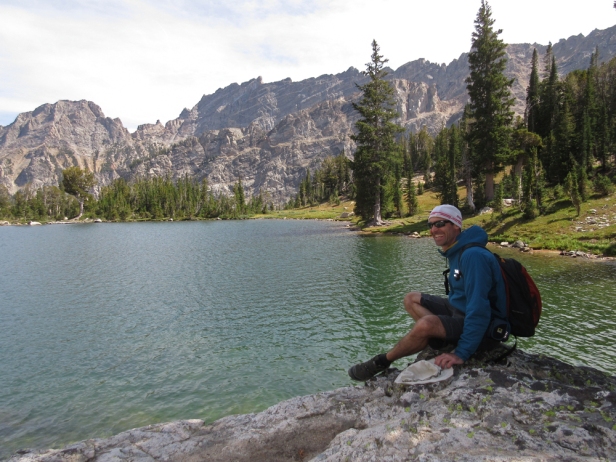
As we started to hike back, we passed a sign for Paintbrush Divide–the high point of the canyon was only two more miles above the lake. Hmm, maybe it would be fun to continue up the trail, I thought. Not all the way to the pass, of course, but just a little higher to get some views.
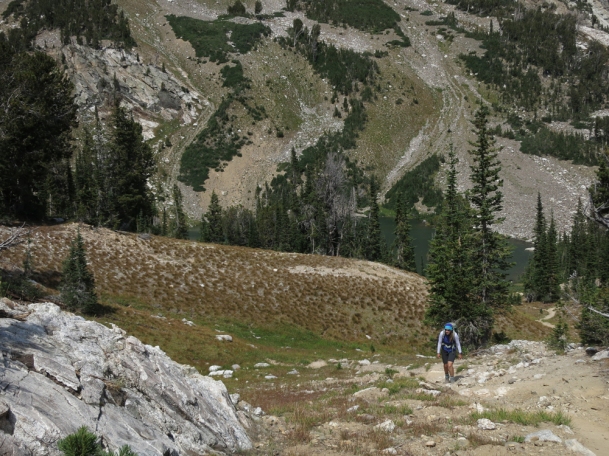
We climbed another mile up the canyon and the vistas seemed to get better with each step we took. Still, it was getting to be late afternoon and we figured it was probably prudent to turn around. Already, it would be a 16-mile round trip. As we were taking a photo at our intended high-point, a hiker came down the trail. She recommended we keep going until we could at least see the path up the divide. We figured it couldn’t hurt to at least take a look at the remainder of the route.

Once we saw the divide before us, the choice was clear. It wasn’t much farther, so we would keep going and turn around once we got to the top. As we made our way up the rocky trail, smoke from a large fire in the northern end of Grand Teton National Park got thicker and obscured the sun. It gave the landscape an eerie, surreal hue that made the hike feel even more adventurous.

Once we crested the divide, we were blasted by the same strong winds that were fueling the distant fire. We hiked along the pass, taking in the views and making sure not to get too close to the edge for fear of getting blown over it. Just as we were about to head back down, two hikers serendipitously approached us. We found out that they were doing the 20-mile loop, only they were traveling in the opposite direction. They had already gone eleven miles and had nine to go.
Doug and I had a realization, we had already done almost half of the 20-mile loop. Why not keep going?

We only had four hours of daylight to cover eleven miles, so we upped the pace. When the terrain allowed, we speed-walked and even jogged a bit. Within an hour, we were at Lake Solitude and an hour after that we were descending Cascade Canyon and looking at up at the spectacular Grand Teton–a peak we climbed in 1992 when we were youngsters in college.

By 8 p.m. we were contouring around the shore of Jenny Lake and soon we were back to the car. We had made it before dark!
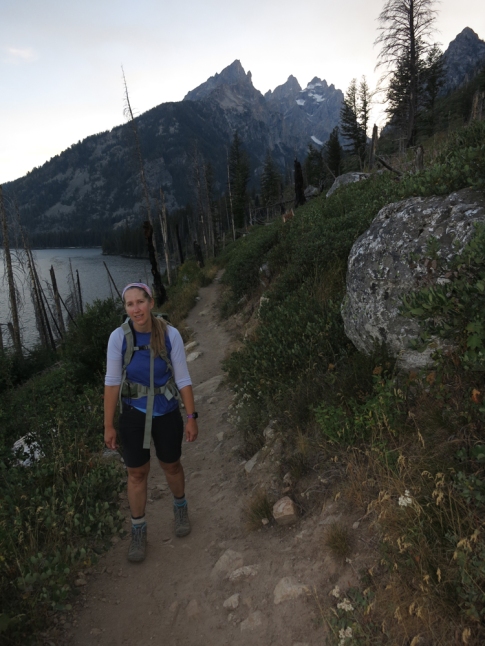
Driving back to the campground, it was hard to comprehend that we had just done a 2o-mile hike. I wasn’t even that sore! I was tremendously happy that we had allowed ourselves the freedom to embark on such a spontaneous adventure. Had we turned around, we would have missed out on one of the most stunning hikes I have ever witnessed.
Spontaneous adventures were something that became elusive for me in later life. In 2006, I was not only diagnosed with ulcerative colitis, I also received the news that I had celiac disease. Due to ulcerative colitis, whenever I traveled, I had to know where restrooms were. With celiac disease, I had to make sure I always packed back-up food in case I couldn’t find gluten-free dining options.
Since my ostomy surgery in 2010, I no longer have to worry about restroom locations for urgency, but I do have to make sure to always have back-up supplies with me. I also have to change my appliance every 3-4 days or my skin isn’t happy. This can impact spontaneity as well. It can be problematic to make a last-minute decision to get up early to climb a peak on a morning when I am scheduled for an appliance change.
With all these things to consider, how do I make sure that I can still have impromptu trips? Simple–I prepare for spontaneity.
This may sound contradictory. After all, spontaneity is the opposite of pre-planning. However, by making sure I am prepared with a few basic supplies, I can be ready for any spur-of-the-moment adventures in the outdoors.
Here are three things I bring with me to make sure I am ready to wing it in the wilderness.
Closed-end ostomy pouches
When on outdoor trips, I most often use drainable pouches and empty them into a “cathole” I dig in the ground. However, I am a hardcore LNT enthusiast, and I strive to follow best practices when disposing of my waste in the backcountry. That means digging holes six inches deep in organically rich soil, 200 feet from water sources, campsites and trails. Unfortunately, good places to bury waste are not always easy to find. Multiply that difficulty by the fact that I have to locate as many as five to eight such places a day with my emptying frequency! If my plans change and I find myself traveling over rocky terrain where digging holes is not possible, or if I need to cover a lot of ground in a hurry (like on our loop hike), swapping out closed-end pouches and packing out the full ones becomes my preferred method for dealing with waste. On every hike I go on, I make sure to bring several closed-end pouches and small plastic bags to pack them out in. Ostosolution Ostomy Pouch Disposal Seals are also handy to snap over the full pouch openings and hold the odor in.
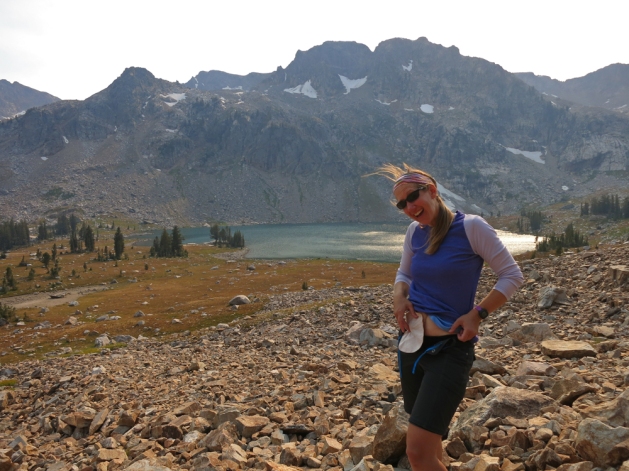
Salty food
You won’t catch me with a few energy and protein bars as my only food source in my pack. I bring a stuff sack full of a wide variety of foods including dried fruit, chocolate, cheese and crackers, bars, peanut butter, cookies, and–most importantly–salty snacks. Since getting an ostomy, I seem to be prone to salt depletion on the trail. It usually starts with nausea and dizziness and then progresses to a gnarly headache with fatigue. All I have to do to make it go away is eat something salty. My doctor told me to always hike with plenty of sodium-rich foods so I make it a habit to bring pretzels, jerky, salted nuts and chips such as Fritos. Also, I always bring a little more food than I need. Yes it adds weight to my pack, but it comes in handy if I change my hiking plans mid-way (or if I were to get injured or lost).
Water filter
As an ostomate, I am also prone to dehydration. On most shorter day hikes, I carry a 3-liter CamelBak. However, this would not be adequate on a bigger hike or if I ended up staying out longer than expected. A great way to remain adaptable to changing water needs is to carry a tool to treat water. I have used a variety of methods including iodine tablets, Aquamira and a SteriPEN. However, my favorite water treatment method is using a water filter. These come in a variety of designs, but my number one choice is the Katadyn Gravity Camp 6L Water Filter. You simply place it in a location that is higher than your water bottle or bladder, and let gravity force water through the filter. No pumping is involved and it filters a liter of water in roughly a minute.
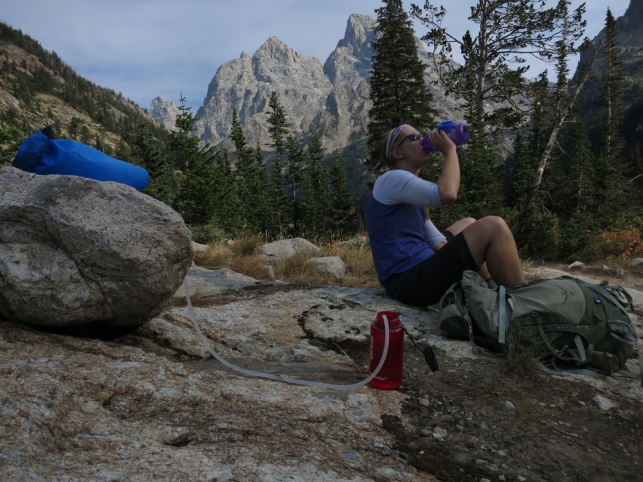
When we were trying to choose whether or not to complete the 20-mile Paintbrush/Cascade Canyon loop hike, we thought about the late hour, our stamina, and encountering mountain lions or bears in the darkness. However, my ostomy never entered the equation as a factor in our decision. I knew that by preparing for spontaneity, I was all set for the unplanned adventure!
